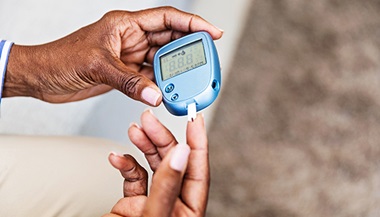Managing Diabetes: Six Healthy Steps with the Most Benefit

Extra pounds? Lose a little. You don’t have to be a “biggest loser” or get an “extreme makeover” to enjoy big weight-loss benefits if you have diabetes. In a nationwide study of 5,145 people with type 2 diabetes, those who shed just 5 to 10 percent of their weight (for someone weighing 175 pounds, that’s a loss of 9 to 17.5 pounds) were three times more likely to lower their A1C (a test of long-term blood sugar control) by 0.5 percent, a significant drop. They were also 50 percent more likely to lower their blood pressure by 5 points and twice as likely to lower their triglycerides by 40 points compared with those whose weight remained the same.
Say yes to fiber-rich foods. When people with diabetes increase the fiber in their diet, they can potentially lower blood glucose over a period of 12 weeks or less, according to a major review of 15 studies. Most people—with or without diabetes—don’t get the recommended 21 to 38 grams of fiber daily. (The American Diabetes Association suggests that diabetics should aim for 14 grams of fiber for every 1,000 calories consumed in a day.) Those who participated in these studies increased their intake by an average of 18 grams a day—the amount in a bowl of higher-fiber breakfast cereal plus a couple of extra servings of vegetables. Whenever you can, choose vegetables, whole grains, and fruit over sugary treats and bread, rolls, and other foods made with refined grains.
Get moving. Starting a regular exercise routine can help people with diabetes lower their A1C by an average of 0.3 to 0.6 percentage points. “Aim for 30 minutes of aerobic exercise—such as walking, riding an exercise bike, or swimming—at least five days a week,” Kalyani suggests. Add two to three light strength-training sessions a week and you’ll build muscle, which uses blood sugar for fuel. In one notable study of 251 people with diabetes, those who participated in aerobic exercise and strength-training every week for nearly six months saw their A1C fall by nearly 1 percent—a drop big enough to reduce risk for diabetes-related microvascular complications by a substantial 35 percent.
Know your ABCs—and beyond. “Because your risk for heart disease is higher with diabetes, it’s smart to see your doctor regularly for checks,” Kalyani says. Have your:
- A1C tested as often as your doctor recommends
- Blood pressure checked at every visit
- Cholesterol tested once a year
In addition, your doctor should check your feet at every visit. You also need an annual eye exam and a yearly kidney-function and urine microalbumin test. Have an annual flu shot and stay up-to-date with your pneumonia vaccine too, Kalyani recommends. And in general, “Talk with your doctor about what you need,” she says.
Monitor blood sugar at home too. Be sure to check your blood sugar levels as often as your doctor recommends. Testing blood glucose at home can give you and your doctor a better idea of how well your medications are working as well as their side effects and other risks, and how your diet and exercise habits are affecting your blood sugar levels, Kalyani says. Of course, more isn’t always better; some people with diabetes can safely be tested every six months without monitoring at home, so talk with your doctor about what’s right for you.
Quit smoking. Nearly one in six people with diabetes are smokers. Tobacco use boosts your risk for heart disease, stroke, blood sugar control problems, vision loss, nerve damage, kidney problems, and even amputation, according to a study review published by the CDC. If you’ve tried to quit in the past, make another attempt. Counseling or a support group plus nicotine-replacement products and medications to help control nicotine cravings can help.
Research Shows Classes Help Improve Blood Sugar Levels
Want more information, support, and advice about practical, everyday ways to stay healthy with diabetes? Ask your doctor about a diabetes self-management class near you. In a 2011 study from The Johns Hopkins University, people who took diabetes-education classes saw their A1C reduced by a significant 0.72 percent.
Definitions
Whole grains: Grains such as whole wheat, brown rice and barley still have their fiber-rich outer shell, called the bran, and inner germ. It provides vitamins, minerals and good fats. Choosing whole grain side dishes, cereals, breads and more may lower the risk for heart disease, type 2 diabetes and cancer and improve digestion, too.
Blood glucose: Also referred to as blood sugar, the primary energy source for the cells in your body. Blood glucose levels rise after meals and fall the longer you’ve gone without eating. Your blood glucose level is a measure of how much glucose you have in your bloodstream. A normal fasting blood glucose level is between 70 and 100 mg/dl (milligrams per deciliter of blood).
A1C Test: A blood test used to diagnose and monitor diabetes. By measuring how much glucose (also called blood sugar) is attached to the oxygen-carrying protein in your red blood cells, this test gives you and your health-care provider a picture of your average blood glucose levels over three months. A normal result is below 5.7 percent. If you have type 2 diabetes, you should have this test done twice a year to check if your blood glucose is under control.





